Chess
Notes
|
| First column | << previous | Archives [64] | next >> | Current column |
6360. Who? (C.N. 6357)
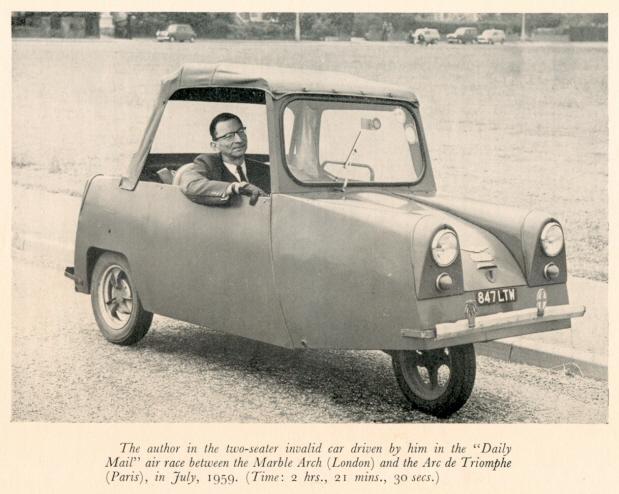
The above photograph, given on page 323 of Chess Facts and Fables, comes from My Way with Polio by Owen Dixson (London, 1963). Dixson is on the left of the picture, also culled from his book, which appeared in C.N. 6357:
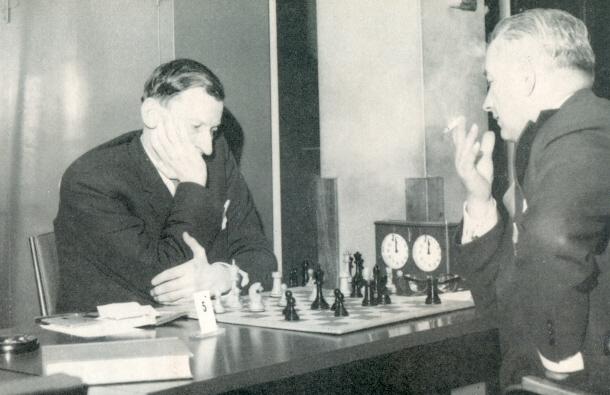
O. Dixson and W.H.
Pratten
6361. Thomas Paine and Robespierre

This is the opening of a five-page comic-strip ‘History was changed in a chess-game’ in the September 1953 issue of Ripley’s Believe it or Not! In the story, Thomas Paine has a last-minute reprieve from the guillotine after his wife, disguised as a young man, defeats Robespierre at chess.
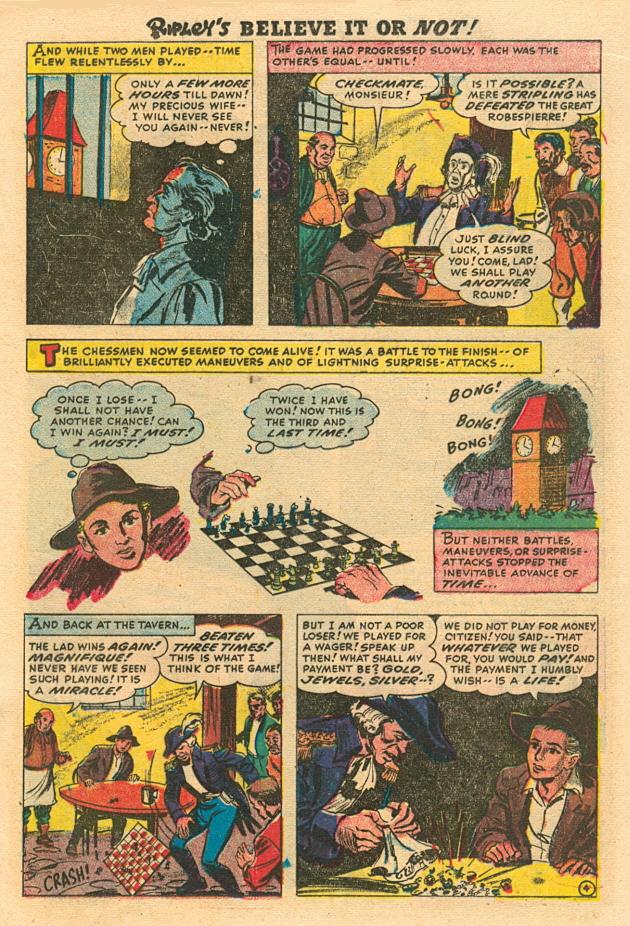
Wanted: other versions of the tale.
6362. Chess for younger readers (C.N.s 6323 & 6329)
Mark N. Taylor (Mt Berry, GA, USA) draws attention to John and the Chess Men by Helen Weissenstein (New York, 1952 and London, 1955), a children’s story which frames a beginner’s chess primer.
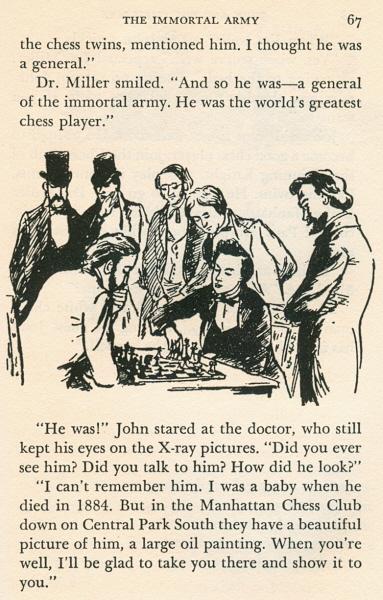
We have a great liking for the book. With considerable skill the author not only teaches the chess basics but gives guidance on etiquette and incorporates some chess history and lore (Franklin, von Kempelen and Morphy).
6363. Round estimate
From page 210 of Every Great Chess Player Was Once A Beginner by Brian Byfield and Alan Orpin (Secaucus, 1974):

6364. Stoltz v Kashdan
Claus van de Vlierd (Oldenburg, Germany) refers to Stoltz v Kashdan, The Hague, 1928, which contained a famous bishop v knight endgame. See, for instance, pages 140-141 of Fundamental Chess Endings by Karsten Müller and Frank Lamprecht (London, 2001).
The ‘standard sources’ do not give the full game, but it appears on page 92 of Peter P. Lahde’s new book on Kashdan (C.N. 6339), the source being ‘Kashdan’s scoresheet’:
Gösta Stoltz – Isaac Irving KashdanThe Hague Olympiad, 30 July 1928
Scotch Game
1 e4 e5 2 Nf3 Nc6 3 d4 exd4 4 Nxd4 Nf6 5 Nc3 Bb4 6 Nxc6 bxc6 7 Bd3 d5 8 exd5 cxd5 9 O-O O-O 10 Bg5 c6 11 Qf3 Be7 12 Rae1 Rb8 13 Ne2 Ne4 14 Bxe7 Qxe7 15 Nd4 Rxb2 16 Nxc6 Qc5 17 Bxe4 dxe4 18 Qxe4 Ba6 19 Re3
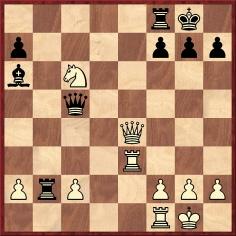
19...Qxc2 20 Qxc2 Rxc2 21 Nb4 Bxf1 22 Nxc2 Bc4 23 Ra3 Rb8 24 h3 Rb7 25 Rc3 Be6 26 Nd4 Bd7 27 Rb3 Rxb3 28 axb3

28...Kf8 29 Kf1 Ke7 30 Ke2 Kd6 31 Kd3 Kd5 32 h4 Bc8 33 Nf3 Ba6+ 34 Kc3 h6 35 Nd4 g6 36 Nc2 Ke4 37 Ne3 f5 38 Kd2 f4 39 Ng4 h5 40 Nf6+ Kf5 41 Nd7 Bc8 42 Nf8 g5 43 g3 gxh4 44 gxh4 Kg4 45 Ng6 Bf5 46 Ne7 Be6 47 b4 Kxh4 48 Kd3 Kg4 49 Ke4 h4 50 Nc6 Bf5+ 51 Kd5 f3 52 b5 h3 53 Nxa7 h2 54 b6 h1Q 55 Nc6 Qb1 56 Kc5 Be4 57 White resigns.
This photograph comes from opposite page 8 of Schackmästaren Gösta Stoltz by E.E. Böök (Stockholm, 1947):
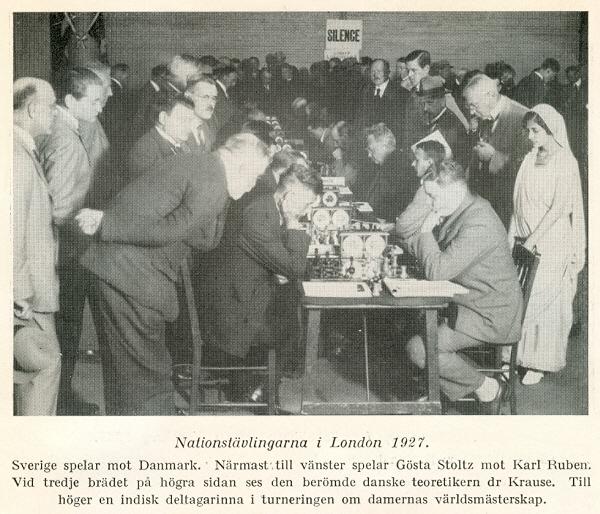
6365. ‘The little Capablanca’
What is known about the origins of Kashdan’s nickname? Our earliest sighting to date is on page 92 of Chess Strategy and Tactics by Fred Reinfeld and Irving Chernev (New York, 1933):
‘“Der Kleine Capablanca” was the nickname given to Kashdan after his earliest European triumphs.’
6366. Responding to Fischer
We have added to Fischer’s Fury the full texts of C.N.s 2268 and 2298. Written in 1999 and published in New in Chess, they responded to Fischer’s criticisms of us over the My 60 Memorable Games affair.
6367. Hort v Fischer
Regarding Hort v Fischer, Palma de Mallorca, 1970, we have been asked by Paul Macklin (Prestwich, England) whether Fischer missed a mate in one at move 55.
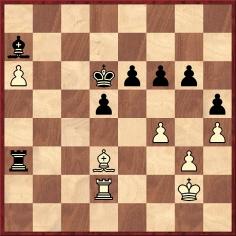
From the above position almost all Fischer books containing the game state that play continued 53...Bb6 54 Rd1 Ra2+ 55 Kf3

Here, Black could play 55...Rf2 mate, whereas Fischer’s move is indicated as 55...Bd4.
However, contemporary sources (e.g. page 61 of the February-March 1971 issue of Mundo del ajedrez) give Black’s 53rd move as ...Be3, which means that no mating opportunity arose two moves later. The matter was raised by Bart Gibbons on page 27 of the January 1976 Chess Life & Review, on the basis of the game’s appearance in the Wade/O’Connell book on Fischer, and in reply to his query Larry Evans remarked that 53...Be3, and not 53...Bb6, had been played.
6368. A forgotten publication
From Michael Clapham (Ipswich, England):
‘The Hackney Review and Stoke Newington Chronicle changed its title on 29 October 1921 to the Hackney Review and British Chess Journal, being described as the “official organ of the London Chess League”. It was published by H. Churchman & Co of Moorgate, London and is not recorded in Betts’ Bibliography.
A weekly publication, it had a chess section of three to four pages which made up a quarter of the paper. The editor was “Ingersoll”, and the chess material was a continuation of his previous columns in the publication. The content included games, problems, correspondence, club news, resorts for chess players and book reviews, and while it was largely focused on London there were also other articles of general interest.
The title was amended on 11 March 1922 to the Hackney Review with the subtitle “British Chess Journal”. As from 24 June 1922 the editors were named as Harold Brown and E.W. Davies. Publication ceased with the 30 December 1922 issue, financial reasons being blamed.’
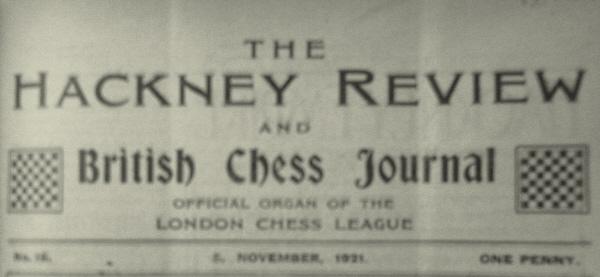
6369. Photograph collection
Olimpiu G. Urcan (Singapore) notes that many chess photographs, including unknown shots of Alekhine, can be found at the website of the Österreichische Nationalbibliothek (Vienna) by making a search for Schach.
6370. Tournament in full swing
Readers may well be able to identify some of the players in this photograph:
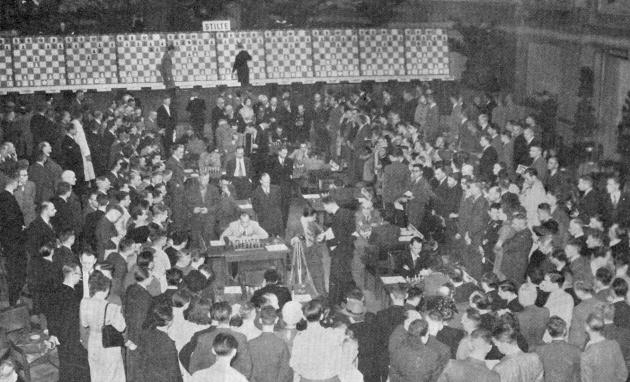
6371. Fischer and Xerox
Serin Marshall (Brooklyn, NY, USA) notes this passage regarding Fischer on page 46 of The Chess Artist by J.C. Hallman (New York, 2003):
‘For a time he seemed perfectly functional – he wrote a column for Boys’ Life, did a television commercial for Xerox, and won money to play in his first interzonal tournament by appearing on a game show.’
Our correspondent asks whether any information is available about the Xerox matter. Our only thought at present is that Bobby Fischer Teaches Chess (New York, 1966) was published by Basic Systems, Inc., ‘an education subsidiary of Xerox Corporation’. The spine:

Below is Fischer’s signature in one of our copies of the first edition.

6372. Batsford Chess Openings
C.N.s 945 and 1159 (see pages 150-152 of Chess Explorations) referred to our spot-check of 60 pre-1945 game references in Batsford Chess Openings (London, 1982), which showed that there were errors in no fewer than 36 of them. Below is the list prepared by us at the time:
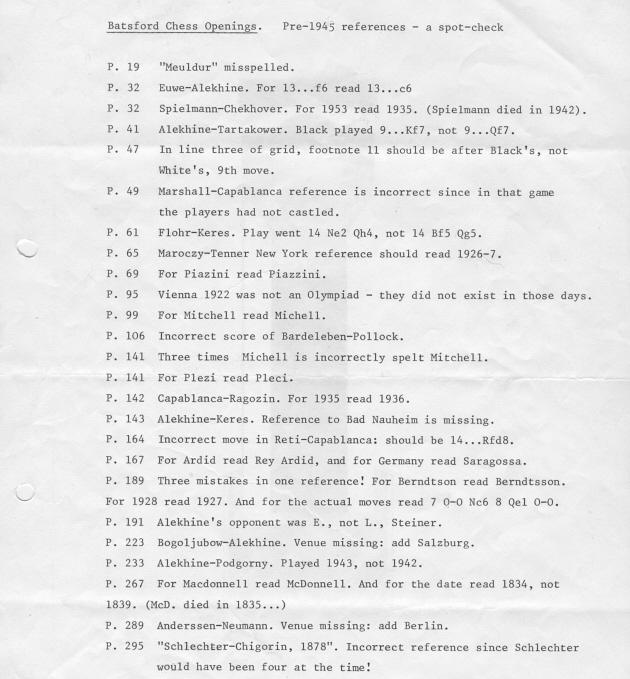
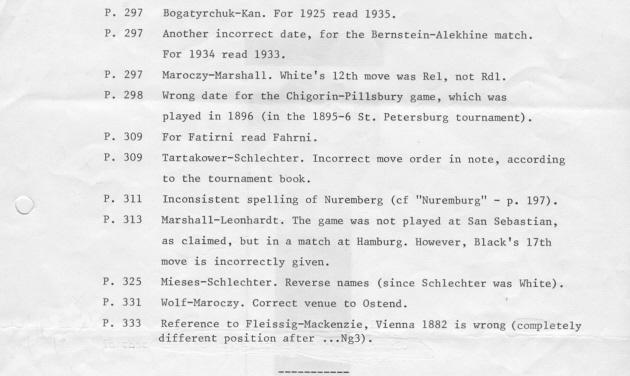
Regarding the attempts by those involved in Batsford Chess Openings to dupe the public over its authorship, the most recent revelations come in the article Ex Acton ad Astra.
6373. A forgotten consultation match
Vitaliy Yurchenko (Uhta, Komi, Russian Federation) has
provided the six games of a consultation match published
on pages 104-113 of the 3-4/1896 issue of Shakhmatny
Zhurnal. The contest was held on the initiative of
P.A. Saburov, and five points were required to win it.
First match-game, St Petersburg, November 1895
Four Knights’ Game
1 e4 e5 2 Nf3 Nc6 3 Nc3 Nf6 4 Bb5 d6 5 O-O Bg4 6 d4 Nd7 7 Be3 Be7 8 dxe5 Ndxe5 9 Be2 Nxf3+ 10 Bxf3 Bxf3 11 Qxf3 O-O 12 Nd5 Re8 13 Rad1 Bf8 14 Bd4 Nxd4 15 Rxd4 c6 16 Nf4 Qb6 17 Qc3 c5 18 Rc4 Qc6 19 f3 Rac8 20 a4 b6 21 Qd3 a6 22 Qd5 Qc7 23 Rc3 b5 24 axb5 axb5 25 Ra3 Re5 26 Qd2 c4 27 Kh1 Qc5 28 c3 Rce8 29 g4 Qc8 30 Ra7 Qd8 31 Nd5 Qh4 32 Qf4 f6 33 Rb7 h6 34 Qg3 Qxg3 35 hxg3 h5 36 gxh5 f5 37 Rxb5 fxe4 38 fxe4 Rxh5+ 39 Kg2 Rhe5 40 Re1 Rxe4 41 Rxe4 Rxe4 42 Rb4 Kf7 43 b3 Ke6 44 bxc4 g5 45 Kf3 Ke5
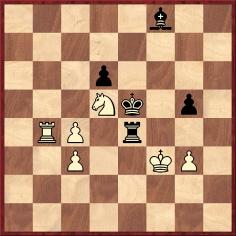
46 Ne3 Rxe3+ 47 Kxe3 Kf5 48 g4+ Ke6 49 Ke4 Bg7 50 Rb6 Bxc3 51 c5 Be5 52 Rxd6+ Bxd6 53 cxd6 Kxd6 54 Kf5 Ke7 55 Kxg5 Kf8 56 Kh6 Kg8 57 g5 Resigns.
Mikhail Ivanovich Chigorin and Peter Alexandrovich Saburov – Alexander Mitrofanovich Levin and Emanuel Stepanovich SchiffersSecond match-game, St Petersburg, November 1895
King’s Gambit Accepted
1 e4 e5 2 f4 exf4 3 Nf3 f5 4 exf5 d5 5 d4 Bxf5 6 Bxf4 Nf6 7 Bd3 Bxd3 8 Qxd3 Nc6 9 O-O Be7 10 Nbd2 O-O 11 Ng5 Qd7 12 Rae1 Bd6 13 Bxd6 cxd6 14 c3 Rae8 15 Rxe8 Rxe8 16 h3 Qe7 17 Qf5 Qe3+ 18 Rf2 h6 19 Ngf3 Ne7 20 Qc2 Ne4 21 Nxe4 dxe4 22 Nd2 d5 23 Nf1 Qg5 24 Qb3
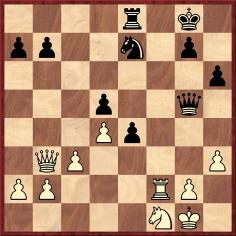
24...e3 25 Re2 Ng6 26 g3 Nf4 27 Rxe3 Rxe3 28 Nxe3 Qxg3+ 29 White resigns.
Alexander Mitrofanovich Levin and Emanuel Stepanovich Schiffers – Mikhail Ivanovich Chigorin and Peter Alexandrovich SaburovThird match-game, St Petersburg, 9 November 1895
Ruy López
1 e4 e5 2 Nf3 Nc6 3 Bb5 Nf6 4 O-O d6 5 d4 Nd7 6 Bg5 Be7 7 Bxe7 Qxe7 8 Nc3 O-O 9 Nd5 Qd8 10 c3 Re8 11 Qc2 a6 12 Bd3 Nf8 13 dxe5 Nxe5 14 Nxe5 dxe5 15 Rad1 c6 16 Ne3 Qg5 17 Kh1 Ng6 18 g3 Bh3 19 Rfe1 h5 20 Bf1 Be6 21 Bc4 h4 22 Bxe6 Rxe6 23 Nf5 h3 24 Qd2 Qf6 25 Qe2 Nf8 26 Rd3 Nh7 27 f4 Rae8 28 Re3 Nf8 29 Qg4 Nd7 30 Qxh3 Nc5 31 Qg4 exf4 32 Qxf4 Re5 33 b4 Ne6 34 Qg4 Rd8 35 h4 Rd7 36 Rd1 Nf8 37 Qf3 Qg6 38 Kh2 Qe6 39 Rxd7 Qxd7 40 Qg4 Ne6 41 Nxg7 Kf8 42 Nxe6+ Rxe6 43 Kh3 Qd2 44 Qe2 Qd7 45 Qg4 Qd2 46 Qe2 Qc1 47 Qe1 Qc2 48 Re2 Qd3 49 e5 Rg6 50 Re3 Qd5 51 a3 Qe6+ 52 Kg2 Qd5+ 53 Kg1 Qc4

54 e6 fxe6 55 Qf1+ Qxf1+ 56 Kxf1 Ke7 57 Kg2 Kf6 58 Kh3 e5 59 g4 Rg8 60 h5 Re8 61 Rf3+ Ke6 62 g5 e4 63 Rf1 e3 64 Kg4 e2 65 Re1 Kf7 66 Kf5 Kg7 67 c4 Re3 68 c5 Re8 69 Kf4 Kf7 70 Kf3 Re5 71 Rxe2 Rxg5 72 Rh2 Rd5 73 Ke4 Kg7 74 Rh3 Kf6 75 h6 Re5+ 76 Kd4 Rd5+ 77 Kc4 Rd8 78 Rd3 Rh8 79 Rd7 Ke6 80 Rxb7 Rxh6 81 Rb6 Rh4+ 82 Kb3 Kd5 83 Rxa6 Rh3+ 84 Ka4 Rh8 85 b5 Kc4 86 Ka5 Rb8 87 a4 cxb5 88 c6 bxa4 89 c7 Rc8 90 Ra7 a3 91 Kb6 Kb3 Drawn.
Mikhail Ivanovich Chigorin and Peter Alexandrovich Saburov – Alexander Mitrofanovich Levin and Emanuel Stepanovich SchiffersFourth match-game, St Petersburg, November 1895
French Defence
1 e4 e6 2 d4 d5 3 Nc3 Nf6 4 Bg5 Be7 5 Bxf6 Bxf6 6 Nf3 c5 7 exd5 exd5 8 Bb5+ Nc6 9 O-O O-O 10 dxc5 Be6 11 Bxc6 bxc6 12 Nd4 Qa5 13 Nb3 Qc7 14 Re1 Rab8 15 Qd2 a5 16 Rab1 Rb4 17 Ne2 Ra8 18 Ned4 Bd7 19 c3 Rc4 20 Qe3 Qa7 21 Nd2 Ra4 22 N4b3 Rxa2 23 Nc1 Ra4 24 Nd3 h6 25 Ra1 Rxa1 26 Rxa1 Qb8 27 Qf3 Bg5 28 Nf1 Qb3 29 Re1 Re8 30 Rxe8+ Bxe8 31 Qf5 Qb7 32 Qe5 Kf8 33 Ng3 Bf6 34 Qf5 Bd7 35 Qf4 Bg5 36 Qe5 Bf6 37 Qe3 Qb3 38 h3 a4 39 Kh2 a3 40 bxa3 Qxc3 41 Nh5 Bd4 42 Qg3 Kg8 43 a4 Bf5

44 Nhf4 Bxd3 45 Nxd3 Bxc5 46 Qb8+ Kh7 47 Ne5 Qe1 48 Nd3 Qe7 49 Nxc5 Qxc5 50 Qc7 d4 51 Qxf7 d3 52 Qf4 Qd5 53 Qd2 c5 54 Kg1 c4 55 Kf1 Qd4 56 Qe3 Qa1+ 57 Qe1 Qxa4 58 f3 Qd7 59 h4 c3 60 Qe4+ g6 61 Ke1 c2 62 Qf4, and the game was drawn a few moves later.
Alexander Mitrofanovich Levin and Emanuel Stepanovich Schiffers – Mikhail Ivanovich Chigorin and Peter Alexandrovich SaburovFifth match-game, St Petersburg, 14 November 1895
Four Knights’ Game
1 e4 e5 2 Nf3 Nc6 3 Nc3 Nf6 4 Bb5 Bb4 5 O-O O-O 6 d3 Bxc3 7 bxc3 Qe7 8 Bg5 Nd8 9 Nh4 Ne6 10 Nf5 Qd8 11 Bh4 c6 12 Bc4 d5 13 exd5 Nf4 14 Bxf6 gxf6 15 Qg4+ Ng6 16 dxc6 bxc6 17 Qf3 Qd7 18 Ng3 f5 19 Qh5 Kh8 20 Qg5 f6 21 Qh6 f4 22 Nh5 Qe7 23 Rfe1 Re8 24 f3 Rb8 25 Rab1 Bf5 26 g4 fxg3 27 hxg3 Rbd8 28 g4 Bc8 29 Re2 Rd6

30 Rb8 Nh4 31 Qe3 Bd7 32 Rxe8+ Bxe8 33 Rh2 f5 34 Rxh4 Resigns.
Mikhail Ivanovich Chigorin and Peter Alexandrovich Saburov – Alexander Mitrofanovich Levin and Emanuel Stepanovich SchiffersSixth match-game, St Petersburg, November 1895
Two Knights’ Defence
1 e4 e5 2 Nf3 Nc6 3 Bc4 Nf6 4 d3 Bc5 5 c3 d6 6 O-O Bg4 7 Be3 O-O 8 Nbd2 Bxe3 9 fxe3 d5 10 exd5 Nxd5 11 Qe1 Nb6 12 Bb5 f6 13 Qh4 Bxf3 14 Rxf3 Ne7 15 Rh3 h6 16 Qg3 a6 17 Bc4+ Nxc4 18 Nxc4 Qxd3 19 Na5 Qc2 20 Rf1 b6 21 Nc4 Qe2 22 b3 Rad8 23 Qf3 Qxf3 24 Rhxf3 b5 25 Nb2 Rd2 26 R3f2 Rfd8 27 Rxd2 Rxd2 28 Rf2 Rd6 29 Rc2 Kf7 30 Kf2 Ke6 31 Ke2 e4 32 c4 c6 33 a4 f5 34 Rc1 g5 35 axb5 axb5 36 Ra1 bxc4 37 bxc4 Ng6 38 Ra8 Ne5 39 Re8+ Kf6 40 Rf8+ Nf7 41 Rc8 Ne5 42 Rf8+ Kg6 43 Re8 Nd7 44 Na4 Kf7 45 Rc8 Ne5 46 Nb6 Rd3 47 Rc7+ Ke6 48 Rh7 Nf7 49 Rg7 Kf6 50 Rg8 Rd8 51 Rxd8 Nxd8 52 Nd7+ Ke6 53 Nc5+ Kd6 54 Nb3 Ne6 55 g3 c5 56 Na5 Nd8 57 Nb3

57...g4 58 Nd2 Nf7 59 Kd1 Ne5 60 Ke2 Kc6 61 Kd1 Kb6 62 Kc2 Ka5 63 Kb3 Nf3 64 Nf1 h5 65 Ka3 Kb6 66 Kb3 Kc6 67 Kc2 h4 68 gxh4 Nxh4 69 Kd1 Kd6 70 Ke2 Ke5 71 Kf2 f4 72 exf4+ Kxf4 73 Ne3 Nf5 74 Nd5+ Ke5 75 Ke2 Kd4 76 Nf6 g3 77 hxg3 Nxg3+ 78 Kd2 Nf5 79 Ke2 Nd6 80 Ng4 Nxc4 81 Nf2 Nb2 82 Ng4 Nc4 83 Nf2 Nd6 84 Nh3 c4 85 Nf4 c3 86 Kd1 Nf5 87 Kc2 Kc4 88 Ng2 Nd4+ 89 Kc1 Nf5 90 Kc2 e3, and White resigned at move 94.
6374. Thomas Paine and Robespierre (C.N. 6361)
David Lovejoy (Mullumbimby, NSW, Australia) mentions the reference to Robespierre in the poem ‘1793’ by Tartakower (C.N. 4278), while Guy Brunet (Montreal, Canada) notes that the man whose life was saved was the Comte de Romilly in the account provided on pages 55-57 of La fabuleuse histoire des champions d’échecs (Paris, 1978) by Nicolas Giffard and réchauffé on pages 349-351 of a book co-authored by Giffard with Alain Biénabe, Le guide des échecs (Paris, 1993).
Mark N. Taylor (Mt Berry, GA, USA) has traced the Robespierre story back to George Walker’s article on the Café de la Régence in Fraser’s Magazine in 1840. It was included on pages 148-184 of Walker’s book Chess & Chess-Players (London, 1850). The relevant section, from page 153:

Our US correspondent has sent us an eight-page compilation ‘Robespierre and chess: the disguised woman anecdote’ which we are authorized to forward to any readers interested. No version of the story found so far in books and articles mentions Thomas Paine.
6375. Elmer Ernest Southard (C.N.s 6350 & 6351)
A specimen of Southard’s play from page 25 of the July 1898 American Chess Magazine:
Elmer Ernest Southard (Boston Chess Club) – Medinus (Chicago Chess and Checker Club)Telegraph match, 30 May 1898
French Defence
1 e4 e6 2 d4 d5 3 Nc3 Nf6 4 e5 Nfd7 5 Nce2 c5 6 c3 Nc6 7 f4 cxd4 8 Nxd4 Nxd4 9 cxd4 Be7 10 Bd3 Nb8 11 Qg4 Bb4+ 12 Kf2 O-O 13 Nf3 f5 14 Qh3 Be7 15 g4 g6 16 Rg1 Kh8 17 Bd2 Qe8 18 Rg3 Rg8 19 Rag1 Bd7 20 gxf5 exf5
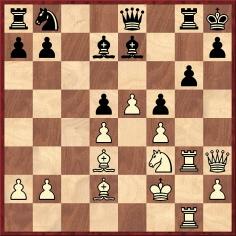
21 e6 Bxe6 22 Ne5 Bf6 23 Rxg6 Bxe5 24 Rxg8+ Bxg8 25 fxe5 Qa4 26 Qh4 Nd7 27 Bh6 Bf7 28 Bg7+ Kg8 29 Bxf5 Bg6 30 Bxg6 hxg6 31 Qh8+ Kf7 32 e6+ Kxe6 33 Re1+ Kf7 34 Qh7 Nf8 35 Bxf8+ Kxf8 36 Qe7+ Kg8 37 Qe6+ Kh7 38 Qf7+ Kh8 39 Qf6+ Resigns.
The previous page of the American Chess Magazine quoted John F. Barry, who played on top board for Boston:
‘Southard you have heard of before, but the rapidity with which he has [improved] and is still improving is wonderful. He has excellent courage, without being impetuous, and is sufficiently cautious to be sound in the combinations he undertakes. His conduct of his game was admirable, making it a gem, and while I think his adversary played weak in the opening, he never had a chance to retrieve himself during the rest of the game.’
Photographs of Southard and Barry from this period appeared in C.N. 5916.
Below, from our collection, is the conclusion of a letter sent by Southard to Dr Charles W. Pilgrim of Poughkeepsie on 18 July 1919:

6376. William MacStravick Stenhouse
An addition to the many C.N. items on poetry (see the Factfinder) is a sequence of compositions on pages 107-118 of Poems, Songs, and Sonnets by William M. Stenhouse (Glasgow, 1886): a five-page poem ‘Telegraphic Chess Contest’ (Christchurch v Dunedin) followed by the sonnets ‘Caissa Regina’, ‘The Pawn’, ‘The Knight’, ‘The Bishop’, ‘The Rook’, ‘The Queen’ and ‘The King’. From page 107:
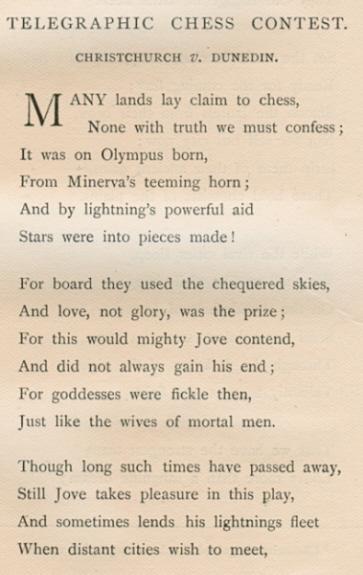
Stenhouse’s inscription in our copy:

Some biographical information about him is available at a New Zealand webpage on physicians and surgeons.
6377. ‘No Higher Stakes’
Morten Hansen (Frederiksberg, Denmark) has sent us a number of pages from the Danish edition of a chess-related story in a war comic, Djævelens slagmark. For example:

Our correspondent points out that the English version of the story is entitled ‘No Higher Stakes’, and he summarizes the plot thus:
‘The action takes place in Burma in February 1942, and the two main characters, General Horikoshi and Captain Grant, are both keen chessplayers. Grant is captured by the Japanese and, when revealed to be a chessplayer, is forced to play a game against Horikoshi with his life at stake. Grant wins, and Horikoshi has to commit suicide.’
We give below a sample page (with references to the ‘Mikalov Gambit’ and ‘Sparski’) from issue 94 of the publication Battle:
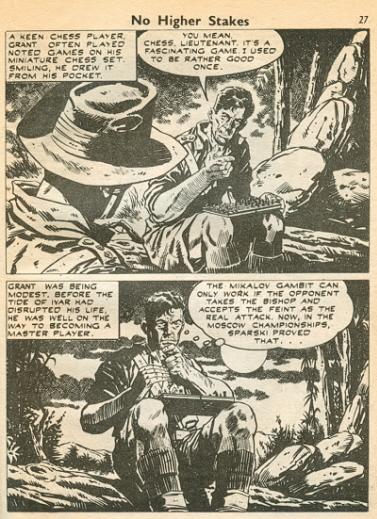
Mr Hansen notes that the story has been reprinted on pages 201-264 of the book Let ’Em Have It (London, 2008).
6378. Capablanca’s US education
In response to a query from George DeRise (Hampton, VA, USA) about Capablanca’s education in the United States we provide a brief summary of the information on pages 10-12 of our monograph on the Cuban, supplemented by illustrations and some further material.
In 1904 Capablanca entered Woodycliff School in South Orange, NJ. The Principal, William Julius Eckoff (1853-1908), was a distinguished educator and author, as is shown by his entry in Who Was Who in America, 1897-1942, page 357:

In C.N. 3333 we added that in 1906 Capablanca was attending Groff School, 228 W 72 Street, New York. This was shown by a letter he wrote to his mother on 22 April 1906:
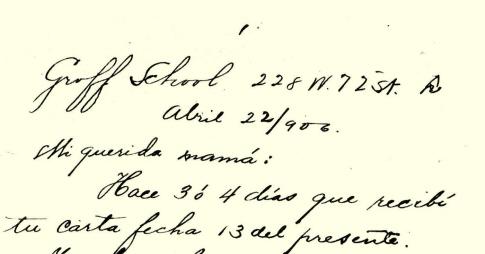
For a full English translation, see page 216 of Chess
Facts
and Fables. The C.N. item mentioned that when our
book on Capablanca was written we had no information
about Groff School and that, even since discovery of the
letter, only one contemporary reference has been found,
an entry in the New York City Directory, 1906-07
(referring to Joseph Groff):

Capablanca’s university record (he was a non-graduate in engineering in the Class of 1910, although we are not sure exactly when the course was broken off) is mentioned on page 134 of the Columbia University Alumni Register 1754-1931 (New York, 1932):
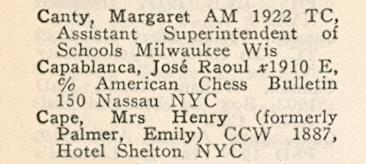
Columbia University holds his alumni information card, which gives his address as Calle 17 No. 512 entre 14716 Vedado, Havana:
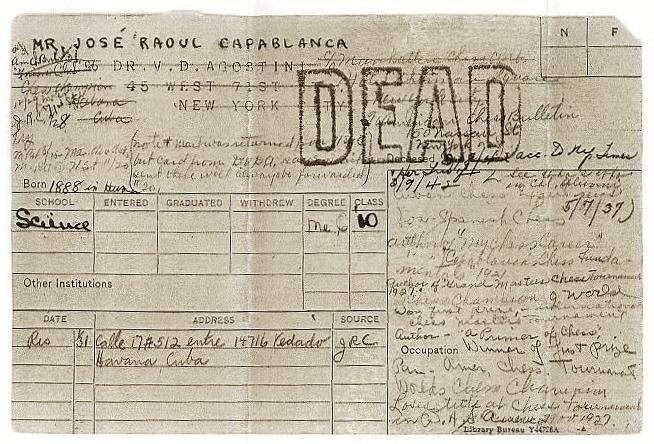
It may be recalled that a photograph of Capablanca in
the Columbia University baseball team (he was second
base) was shown in C.N. 5108, taken from The
Columbian 1909, page 140. Below is a detail:
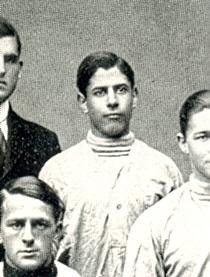
José Raúl Capablanca
Page 65 of the same edition of The Columbian was devoted to the Columbia Chess Club and listed Capablanca as the ‘Varsity Team Captain’.
6379. New Lasker book
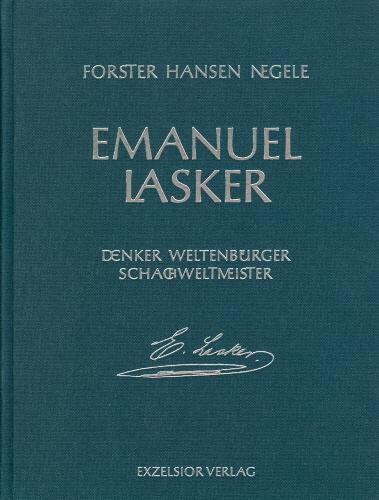
A mammoth book of exceptional quality has just been published: Emanuel Lasker: Denker Weltenbürger Schachweltmeister edited by Richard Forster, Stefan Hansen and Michael Negele (Berlin, 2009). It is a beautifully-produced hardback – 1,079 large pages (German text) with hundreds of photographs, many previously unseen. The two dozen contributors of the chapters on various aspects of Lasker’s life and careers include John Donaldson, John Hilbert, Robert Hübner and Victor Korchnoi.
The book, simply unmissable, can be acquired direct from the publisher, Exzelsior Verlag.
6380. Wikipedia grab-bags
A grotesque publishing innovation is a series of books which, self-confessedly, are no more than grab-bags of Wikipedia entries. Slim volumes on Capablanca and Lasker have just been in our hands, as briefly as possible.
Readers who visit amazon.com and enter ‘Alphascript’ for the publisher and ‘chess’ for the keyword will see that the adjective ‘grotesque’ also applies to the prices.
6381. Reprobates
Of course, books by ‘known’ writers/players may also be unworthy of a second glance. Nevertheless, for some of chess literature’s reprobates there mysteriously persists a certain fan-base, however insignificant: speed-readers duped by speed-writers.
6382. von Holzhausen v Tarrasch
C.N.s 1720 and 1779 (see page 200 of Chess Explorations) discussed this famous game:
Walther von Holzhausen – Siegbert TarraschSimultaneous display, Frankfurt, 7 October 1912
Two Knights’ Defence
1 e4 e5 2 Nf3 Nc6 3 Bc4 Nf6 4 d4 exd4 5 O-O d6 6 Nxd4 Be7 7 Nc3 O-O 8 h3 Re8 9 Re1 Nd7

10 Bxf7+ Kxf7 11 Ne6 Nde5 12 Qh5+ Kg8 13 Nxd8 Rxd8 14 Nd5 Resigns.
It is often claimed that, from the diagram, play went 10 Bxf7+ Kxf7 11 Ne6 Kxe6 12 Qd5+ Kf6 13 Qf5 mate, but all the contemporary sources that we have consulted have Black resigning at move 14. In C.N. 1779, for instance, page 367 of Deutsches Wochenschach, 13 October 1912 was mentioned by a correspondent, and below we reproduce the relevant part of page 345 of the November 1912 Deutsche Schachzeitung:
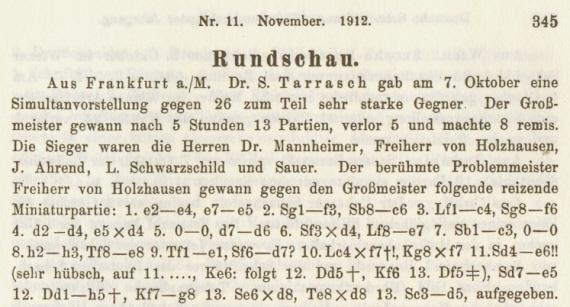
Many books have gone awry. Page 42 of Le guide des échecs by N. Giffard and A. Biénabe (Paris, 1993) gave the 13 Qf5 mate version and stated that the game was played in Hamburg in 1910. No corrections have been made in the new edition (Paris, 2009). Page 62 of Chess Tactics by P. Littlewood (Ramsbury, 1984) transferred the game to Berlin (with the correct date, 1912) and said that Tarrasch resigned after 10 Bxf7+. The text was left uncorrected when a new edition was published by Batsford in 2004. Page 181 of Combination in Chess by G. Négyesy and J. Hegyi (Budapest, 1965) gave the conclusion as 11 Ne6 Resigns, adding: ‘What is more, a few years before, the same combination occurred in a game played in the Soviet Union [sic].’ The identical text appeared in the revised edition (Budapest, 1970).
How far back the various errors can be traced is difficult to say, but we note that pages 108-109 of Tartakower’s Bréviaire des échecs (Paris, 1934) had the 13 Qf5 mate version (with Hamburg as the venue and 1910 as the date).
6383. Incorrigible (C.N. 6206)
As noted in Historical
Havoc (an article we published in 1998), page 13
of World Champion Openings by Eric Schiller (New
York, 1997) referred to ‘Emil Zukertort’. Any
respectable writer would, of course, take the earliest
possible opportunity to correct the blunder.
Consequently:

World Champion Openings by E. Schiller (first edition – New York, 1997)
World Champion Openings by E. Schiller (second edition – New York, 2002)

World Champion Openings by E. Schiller (third edition – Las Vegas, 2009).
A few lines later, in all three editions, mention is made of another world championship challenger, Isidore [sic] Gunsburg [sic].
6384. Tournament in full swing (C.N. 6370)

This photograph was culled from Groningen 1946 by M. Euwe and H. Kmoch (Groningen, 1947), with a caption giving no names but stating that the picture had been taken during the first round, on 13 August 1946. The pairings, from page 32:
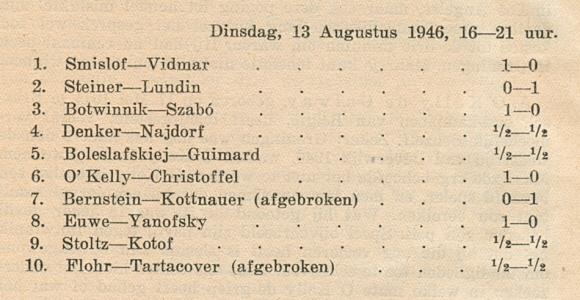
The identification question will be left open a little longer, and in the meantime we reproduce a group photograph from the same book:
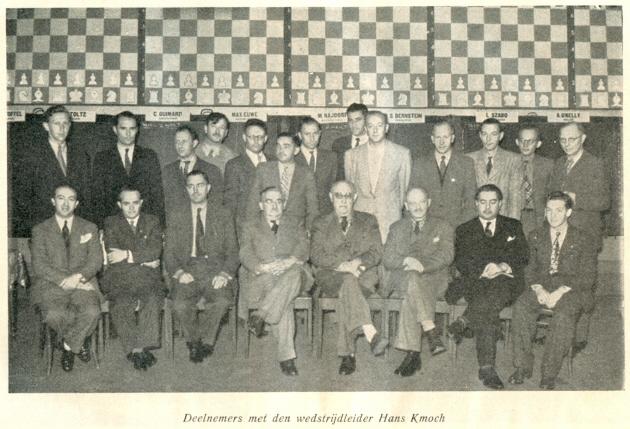
6385. Mate by castling (C.N. 2924)
From page 123 of the first Czech book on chess, Příruční kniha šachovní by K.B. Kober (Prague, 1875):

The heading states that this neat win by Antonín Kvíčala occurred at the Sokol Café (in Prague) on 16 April. No year was provided, but the neighbouring games suggest a date between 1866 and 1874.
We now note that in C.N. 2924 (see page 43 of Chess Facts and Fables) Black’s 16th move was given as ...Be7 instead of ...Bg7. The corrected score: 1 e4 c5 2 Bc4 Nc6 3 Nf3 e6 4 Nc3 a6 5 d4 b5 6 d5 bxc4 7 dxc6 d6 8 e5 d5 9 Bg5 f6 10 exf6 Nxf6 11 Ne5 h6 12 c7 Qxc7 13 Bxf6 gxf6 14 Qh5+ Ke7 15 Qf7+ Kd6 16 Qxf6 Bg7
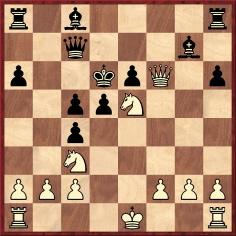
17 Ne4+ dxe4 18 O-O-O mate.
6386. Early books by women
Andreas Lange (Berlin) asks whether there is an older chess book by a woman than The Chaturanga; or, Game of Chess by Mrs Colonel Hartley (London, 1841):

6387. Victor Buerger
From Adrian Harvey (Edgware, England) comes a request for information about Victor Buerger (later: Berger).
Buerger defeated Alekhine at Margate, 1937 in a game which featured ‘the worst blunder ever seen on a chessboard’, according to Irving Chernev on page 77 of Wonders and Curiosities of Chess (New York, 1974). The game was presented with notes (‘based on post-play analysis and discussion by the contestants themselves’) on pages 281-283 of CHESS, 14 April 1937, with the sequence 36...Qxf4 37 Nxe4 described as ‘probably the most incredible double oversight in the history of first-class chess’.
Relatively little information is available at Buerger, who died in 1996 (BCM, May 1996, page 259). He was the subject of a tribute article by William Winter on pages 302-305 of CHESS, 14 April 1936, which included Buerger’s win over Bogoljubow at Scarborough, 1927 and referred to his victories against Colle and Réti. It was noted too that ‘Buerger, der Ideenreiche’ was Tartakower’s phrase in Neue Schachsterne (Vienna, 1935); see pages 14-18, which include Buerger’s short victory over Sir George Thomas at Hastings, 1926-27.
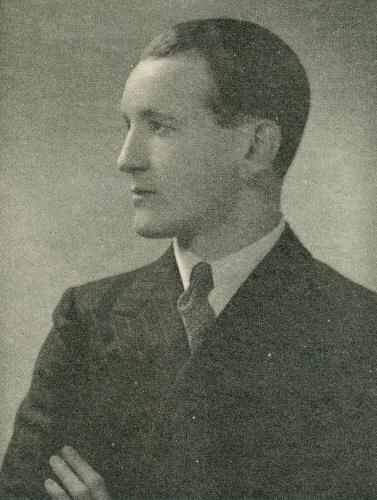
Victor Buerger in CHESS, 14 April 1936, page 303
An interesting claim made by William Winter on Buerger’s behalf:
‘He has chased the Wing Gambit completely off the board by his variation (first played against Yates in 1926) 1 P-K4 P-QB4 2 P-QKt4 PxP 3 P-QR3 P-Q4! 4 P-K5 Kt-QB3 5 P-Q4 Q-B2! 6 Kt-KB3 B-Kt5, in which Black secures an equal development with a safe pawn ahead.’
Below is the full game, from page 70 of the Chess Amateur, December 1926 and pages 66-67 of The “British Chess Magazine” Chess Annual 1926 by M.E. Goldstein (Leeds, 1927):
Frederick Dewhurst Yates – Victor BuergerSecond Invitation Tournament, London, October 1926
Sicilian Defence
1 e4 c5 2 b4 cxb4 3 a3 d5 4 e5 Nc6 5 d4 Qc7 6 Nf3 Bg4
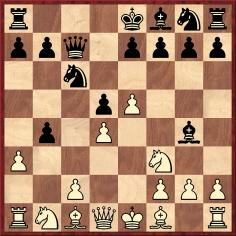
7 axb4 Nxb4 8 c3 Nc6 9 Na3 a6 10 Be2 e6 11 O-O Rd8 12 Qa4 Ne7 13 Be3 Nc8 14 Rfb1 Bf5 15 Rb2 Be7 16 Nc2 O-O 17 Bd2 Nb8 18 Qb3 b5 19 Nb4 Bxb4 20 cxb4 Nb6 21 Rc1 Nc4 22 Bg5 Rc8 23 Ra2 Qb7 24 Raa1 Rc6 25 Nh4 Bg6 26 Qg3 Rc7 27 Bg4 Nc6 28 Qc3 a5 29 Nxg6 axb4 30 Qd3 hxg6 31 Rab1 Ra8 32 Rd1 Ra3 33 Qe2 Qa7 34 Be3 b3 35 h4 b2 36 Kh2 Ra1 37 Qe1 Rxb1 38 Rxb1 Qa2 39 Be2 Na3 40 Bd3 Nxb1 41 Bxb1 Qa1 42 h5 gxh5 43 Qf1

43...Nxe5 44 dxe5 Rc1 45 White resigns.
The game may be found in databases with White’s 14th move given as 14 Rab1, but both our sources state that the king’s rook was moved.
| First column | << previous | Archives [64] | next >> | Current column |
Copyright: Edward Winter. All rights reserved.